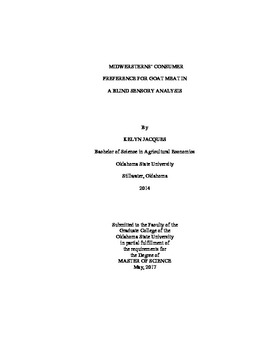| dc.contributor.advisor | Norwood, Franklin B. | |
| dc.contributor.author | Jacques, Kelyn | |
| dc.date.accessioned | 2018-03-13T18:15:51Z | |
| dc.date.available | 2018-03-13T18:15:51Z | |
| dc.date.issued | 2017-05-01 | |
| dc.identifier.uri | https://hdl.handle.net/11244/54543 | |
| dc.description.abstract | Goat meat is commonly eaten around the world, though only rarely by Americans, and it is unclear whether this is due to its taste or some other reason. A blind sensory analysis was performed to determine U.S. consumers' preference is for goat meat compared to beef and pork. Goat shoulder, beef brisket, and pork shoulder were all slow cooked and shredded, and a group of consumers in the State of Oklahoma rated each meat using a nine-point hedonic scale in four categories. Logit modeling revealed goat, beef, and pork all received similar favorable ratings from participants, though pork and beef were slightly favored to goat. These results demonstrate why Americans consume more beef and pork than goat, but does not explain why goat is consumed so seldom. | |
| dc.format | application/pdf | |
| dc.language | en_US | |
| dc.rights | Copyright is held by the author who has granted the Oklahoma State University Library the non-exclusive right to share this material in its institutional repository. Contact Digital Library Services at lib-dls@okstate.edu or 405-744-9161 for the permission policy on the use, reproduction or distribution of this material. | |
| dc.title | Midwersterns' Consumer Preference for Goat Meat in a Blind Sensory Analysis | |
| dc.contributor.committeeMember | Melstrom, Richard T. | |
| dc.contributor.committeeMember | Lusk, Jayson L. | |
| osu.filename | Jacques_okstate_0664M_15106.pdf | |
| osu.accesstype | Open Access | |
| dc.description.department | Agricultural Economics | |
| dc.type.genre | Thesis | |
| dc.type.material | text | |
